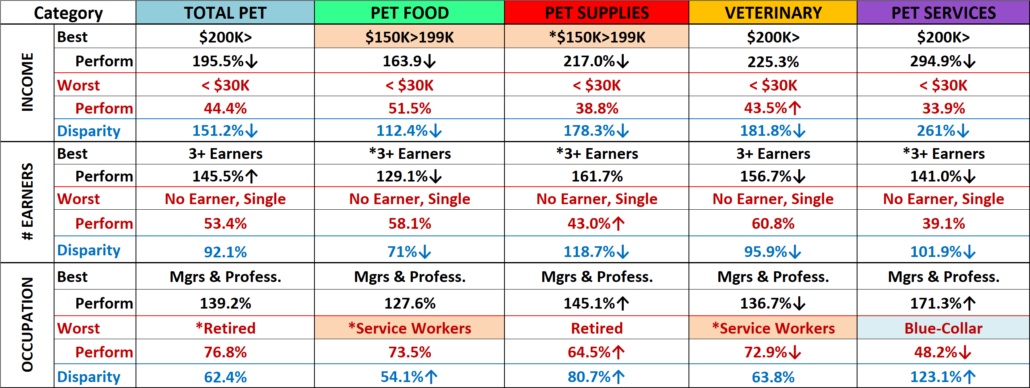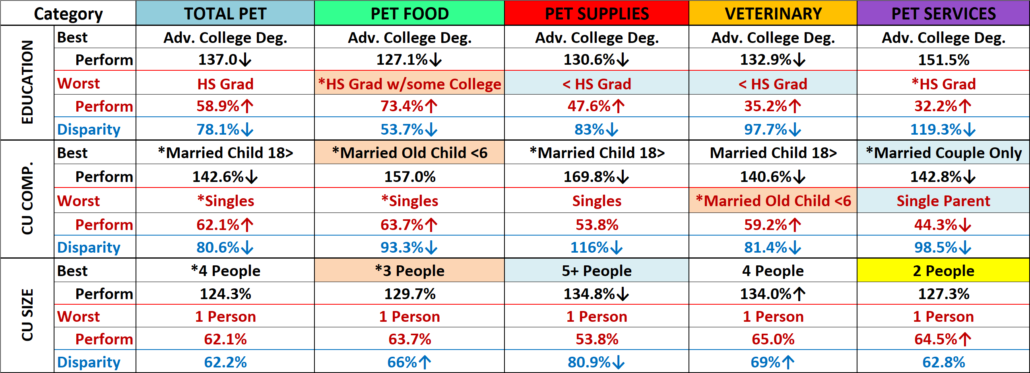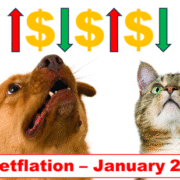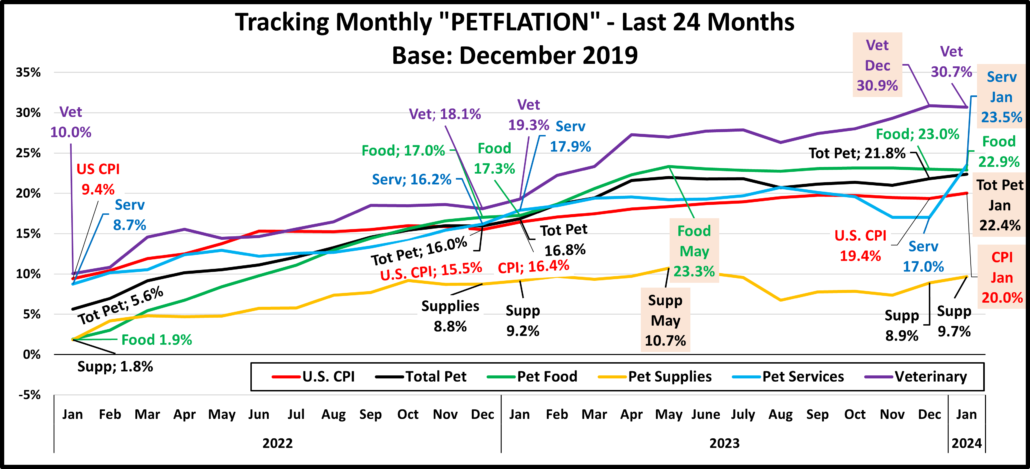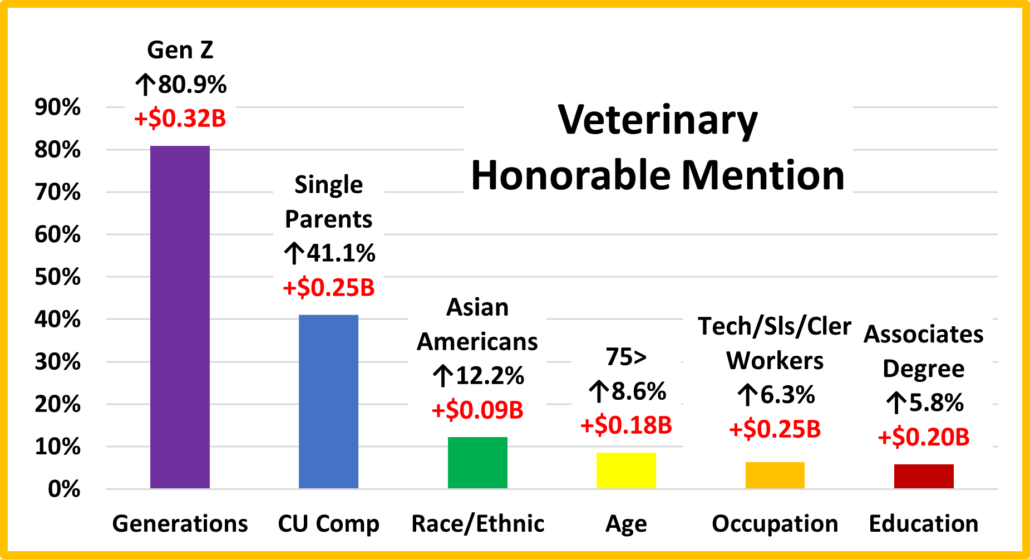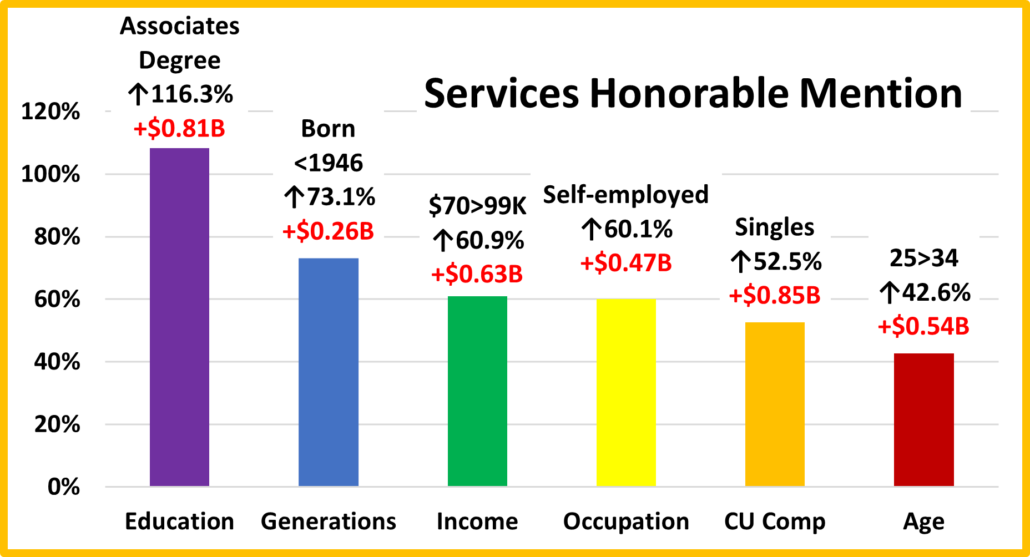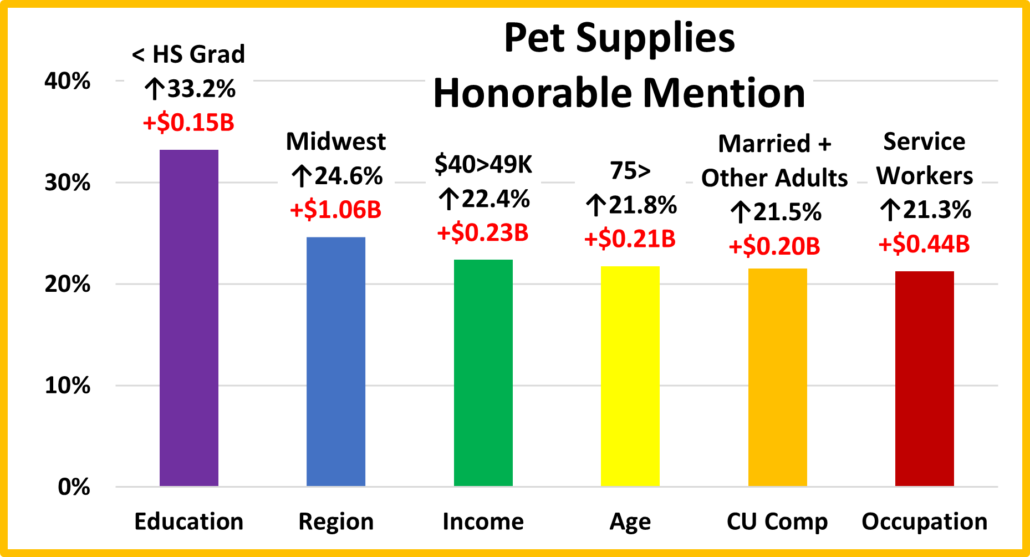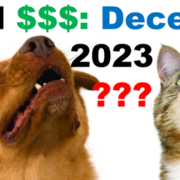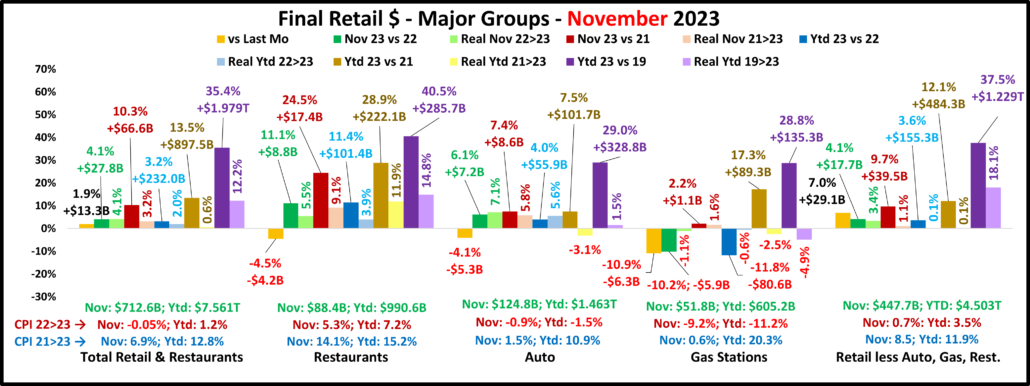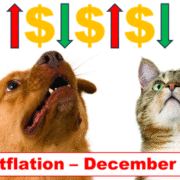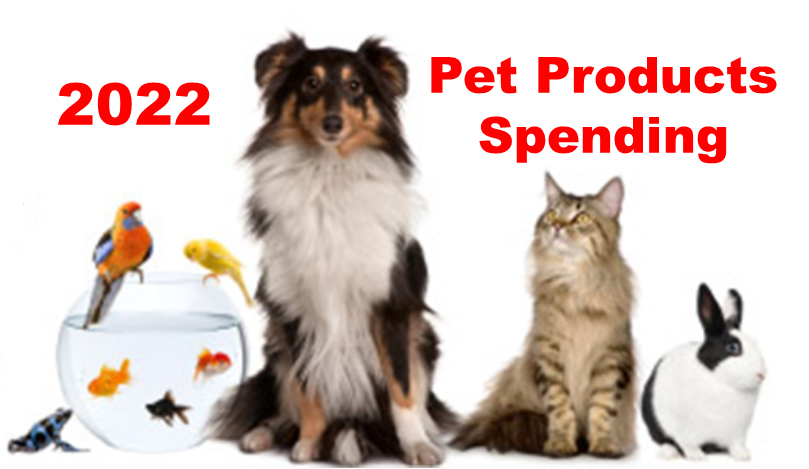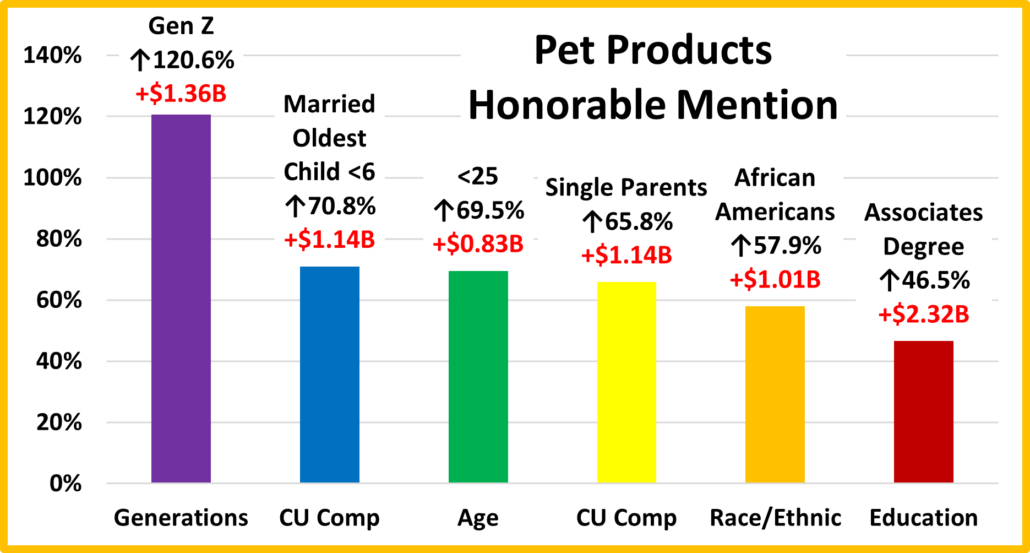Comparing the Spending Demographics of the Industry Segments – SIDE BY SIDE
The first reports of our Pet Spending Demographics analysis have been very detailed and intense. We looked at the industry as a whole and each of the individual segments. Recent years have seen some turmoil. We have seen the very real impact of outside influences on the industry. In the 2nd half of 2018, the FDA warning on grain free dog food caused a $2.3B drop in Food $ and new Tariffs flattened Supplies $, but Services had a record lift. In 2019, Food rebounded but the tariffs really hit the Supplies segment with a $3B drop. Veterinary $ grew slightly while Services $ fell a bit. The net was -0.2% drop in Total Pet. The 2020 pandemic had varied impacts as Pet Parents focused on needs. This caused a lift in Veterinary and a huge increase in Food because some demographics binge bought out of fear of shortages. Services spending plummeted due to outlet closures and restrictions while Supplies $ continued to fall because consumers saw them as more discretionary. 2021 brought a big change, Food $ fell because there was no “binge” repeat. However, Pet Parents focused on their “children” producing a widespread record lift in all other segments and a record $16B increase. In 2022, after the record lift in 2021, spending fell in Supplies and Veterinary but Food had a strong 12.5% increase and Services continued to surge. This combination produced a 2.7% increase in Total Pet $
We have often referenced the similarities and differences in spending between Total Pet and the individual industry segments. Total Pet Spending is a sum of the parts and not all parts are equal. In this final report we are going to put the segments side by side to make the parallels, differences and changes from 2021 more readily apparent. We will address:
- “The big spenders” – those groups which account for the bulk of pet spending.
- The best and worst performing segments in each of twelve demographic categories
- The segments with the biggest changes in spending $ – both positive and negative
- “Honorable Mention” – Only segments that received this “honor” at least twice in 2022
- And of course, the “Ultimate Spending CUs”
The emphasis is on “visual” side by side comparisons to allow you to quickly compare the industry segments. We’ll try to minimalize our comments. You can always reference one of the specific reports for more details. We’ll also break the charts up into smaller pieces that are demographically related to make the comparison more focused and easier.
Before we get started, let’s take a look at the current market share of the industry segments. The following 2 charts show the 2022 share of spending for each segment and the evolution over the past 30 years. 1992 was the last year that the Food Segment accounted for 50% of Total Pet Spending. By the way, Total Pet Spending was $16.2B in 1992. We have come a long way, +534%; annual growth rate of 6.35%. This will help put our comparisons into better perspective.
2021>2022 CHANGE IN SHARE of TOTAL PET $
Food: 37.7%; Up from 34.4%
Supplies: 21.4%; Down from 23.8%
Veterinary: 28.9%; Down from 32.7%
Services: 12.0%; Up from 9.1%
In 2022, Supplies & Veterinary lost almost 7% of share in Total Pet $ which was picked up by Food & Services. The most notable trend from 1992 to 2012 was the decline in Food share while Supplies gained in importance. Both of those have ended. In recent years, the Product Segments have been on a rollercoaster. Food reached 44% in 2020, the highest level since 44.8% in 1998. Supplies have been trending down since 2012, hitting bottom at 18.1% in 2020. The Services segments have been more stable. They have generally trended up since 2012. After falling to 8.2% in 2020, Non-Vet Services peaked at 12% in 2022. Except for the big lift in 2021 which pushed them above 30%, Veterinary has been in the 25>28% range since 2012. All are impacted by outside influences but big trends in Food and Petflation in Supplies tend to make the Product Segments more volatile than the Services Segments.
Now let’s get started with a look at the “Big Spenders”. The following 2 charts will compare the market share and performance in all Pet Industry segments by the groups responsible for the bulk of the spending in 10 demographic categories. These are the groups that we identified in our Total Pet analysis to generate at least a 60% market share of spending. As you recall, to better target the spending we altered 3 groups in Services (Area, Education and Income) and 1 in Veterinary (Education). However, to have a true side by side comparison we need to use the same groups for all. Since these 4 groups are a different size from our original analysis, the share of spending will be different. However, all meet or exceed our 60% share minimum.
The chart makes it especially easy to compare share and performance across categories. Remember, performance levels above 120% show a very high level of importance for this category in terms of increased spending. Unfortunately, it also indicates a high spending disparity among the segments within the category. There are 2 charts, each with 5 categories. The categories are listed in their order of share of Total Pet $ – from highest to lowest.
- White, Non-Hispanic – This group has an 81+% market share in every Segment. Minorities account for 32.8% of CUs but only 14>18% of spending in any segment. Factors: Lower income for Hispanics and African Americans and lower Pet ownership in Asians and African Americans. Whites lost share in Total & Products but gained in both Service segments. Asians had the same pattern and Hispanics were down in all but Food. African Americans gained in all.
- Homeowners – Homeownership is very important in Pet Ownership and subsequently in all Pet Spending. It also increases with age. Only the Supplies share is below 80%. The group gained 1.2% in Total Pet share. The only decrease was -0.2% in Food. The lift was driven by those w/o a mortgage. They had gains in all but Veterinary. Those with a mortgage also had a small increase in Total but their only segment gain was a 3.1% increase in Veterinary.
- 2+ People in CU – 2+ is still the key in pet ownership. However, the results were mixed by size. Singles had more CUs but lost share in all but Services so 2+ CUs had the opposite pattern. 2 People only gained in Supplies & Services. 4 people had the opposite pattern but 3 People gained in all. 5 People was the only 2+ size to gain in share of CUs but they only gained share in Food spending and had the biggest drop in Total Pet.
- Suburban & Rural – They lost -0.1% in Total Pet but gained in Food & Services. Both the Suburbs 2500> and Areas <2500 had drops in Veterinary but opposite patterns in Total and the other segments. The Big Suburbs were only up in Food. The areas <2500 only lost share in Food. Center City was up in Total due to gains in Veterinary & Supplies.
- Associate’s Degree > – A huge drop in spending by College Grads caused us to expand this group to include those with an Associate’s Degree to reach our 60% minimum share. This resulted in an increase in share but a drop in performance for all segments. Despite a great year from Associate’s Degree, the new group lost share in all but Services from 2021. Overall, Higher Education is also less important. In 2021, it usually ranked 2nd. In 2022, it is still 2nd for Services but fell in Total and all other segments, even falling to 7th in Food.
- Over $70K Income – INCOME MATTERS MOST IN PET SPENDING! Income has grown in importance in recent years and all Industry segments, but Food performed at 140+%. Over $70K gained 2.5% in CU share but lost -0.7% in Total, -2.6% in Food and -1.8% in Veterinary. The other segments gained share – Supplies, +2.6% & Services, +3.0%. The <$70K group obviously had the exact opposite pattern. Food & Veterinary spending became slightly more balanced while the income spending disparity gap widened for the discretionary Supplies & Services segments.
- Everyone Works – Income is important, but the importance of # of Earners fell for all but Food in 2022. Despite a strong year for 3+ Earners the Everyone works group lost share in all but Food. The Food lift was strong enough to generate a gain in Total. In terms of performance, only Services is 120+%. In 2021, Supplies & Vet were also 120+%.
- All Wage & Salary Earners– Incomes vary widely in this group, so performance is often lower. 2022 was different. The group gained 0.9% in CU share. Total Pet and all segments, but Veterinary gained in spending share. Veterinary lost -0.5% in share and -2.6% in performance. Supplies had the biggest lift – +7.8% in share and +11.4% in performance. The increase was driven by a combination of Managers/Professionals and Blue Collar workers.
- Married Couples – Marriage is 1st in importance to spending in Food, 2nd in Total, Supplies & Veterinary but falls to 3rd in Services. In 2022 their share & performance increased in Total, Food & Services but fell in Veterinary & Supplies. The best performer inside the group was CUs with a child 18>. Outside of the group, it was Single Parents.
- 35 to 64 yrs – Includes the 3 highest income segments. They only gained share in Total Pet (+0.3%) and Food (+6.0%). The 45>54 yr-olds gained share in all segments but their lift couldn’t overcome big losses by the 35>44 yr-olds in all segments but Food. The good news is that their Food share is now above 60% (61.1%).
Now we’ll look at the Best/Worst performers in each category. Highlighted cells are different from Total Pet; * = New Winner/Loser; ↑↓ = 5+% Performance Change from 2021. The categories are divided into related groups. 1st, Income
- Income – Income matters. All winners were $150K>. The Supplies winner was $150>199K down from $200K> in 2021 and the disparity between 1st and last place fell by 90%. The disparity gap in Veterinary narrowed by only 5% but it narrowed by at least 30% for Food, Services & Total Pet. More balanced spending.
- # Earners – More earners = more income. The highest income 3+ Earners segment is now on top for all. Note: They are most likely Gen Xers. No Earner, Singles (70+ yr-olds) retained their position at the bottom. The spending disparity gap narrowed by only 6% for Supplies. In the other segments it shrank by at least 15%.
- Occupation– Mgrs & Professionals are #1 in CU income and expenditures and again the best performer in all segments. Blue Collar workers had a strong year in all but Services. They were replaced at the bottom by Service Workers or Retirees. The spending disparity actually increased by 21% in Services and by 4>9% in Food, Supplies & Total Pet. It did fall slightly, -3.5% in Veterinary.
Next are demographics of which we have no control – Age, Generation and Racial/Ethnicity
- Racial/Ethnic– As expected, White Non-Hispanics are the top performer in all segments and African Americans occupy all the bottom slots. African Americans have the lowest income and only 25% own Pets. However, they had a strong 2022. They got the performance gap below 100% in all segments, including a 24% drop to 75% in Supplies.
- Age – The 45>54 yr-olds now “rule”. The bottom is a mixture of young & old. 75> is the worst in Products while <25 loses in Services & Total. The spending disparity increased by 10% to 110% in Veterinary, but it fell in Total and all other segments, including a 62% drop in Supplies to 75%. Now, only the disparity in Veterinary is above 100%.
- Generation – Gen X still “rules”. Gen Z is still at the bottom in Service segments while Born <1946 is the worst in the others. The disparity gap narrowed for all. The drop was in double digits for all but Veterinary. Now, all are <100%.
In the next 6 categories, we have at least some control
- Education – Winning is tied to higher Education which generally correlates with income. The losers are all below an Associate’s degree. The disparity gap shrank significantly for all with an average drop of 53%. Only Services is 100+%.
- CU Composition – 7 of 10 best/worst are different from 2021. Except for Services, kids win. The oldest kid 18> aligns with the 45>54 age group. Singles are the most common worst. Disparity lessened for all – an average drop of 32%.
- CU Size– The top CU number is mixed, but generally 3+. “1” remains solidly on the bottom. The disparity is also bigger in all but Supplies. Disparity dropped 60% in Supplies and 4% in Services but rose in Total & other segments.

- Housing – The perennial winner and loser. Disparity dropped slightly in Products & Services but rose in Vet & Total.
- Area– <2500 population is on top & Central City is on the bottom. The disparity dropped by 9+% for Total and all but Services, which increased by 11%. This is a surprise. Services spending usually skews towards higher population.
- Region – A strong year for the Midwest. The South is at the bottom in all but Supplies. The disparity in Food increased by 0.3%. Total & all other segments had double digit drops, led by Supplies which fell 62%.
Here are the categories with the biggest & smallest disparities for Total Pet & each industry segment.
I’m sure the fact that income produces the biggest spending disparity for all is no surprise. Pet spending is driven by income. The Regional “wins” reflect the growing national balance in product spending. In Area Type, Services spending is expanding beyond high population areas while Veterinary spending is now growing in Center City.
Now, here are two summary charts. The first compares the averages.
The return to “normal” is very apparent as the differences for all but Supplies are below 2019 levels. Supplies did have the biggest drop from 2021 (40%) and are less than 1% above 2019. Food has the lowest disparity for the 2nd straight year. The difference grows as you move from Products to Services. Non-Vet Services is again on top. The Veterinary disparity also fell but it is back to the 2nd highest. Total Pet fell 16% from 2021 to 78%, much more balanced.
- Food – Down 13% from 2021, 16% from 2019, but 145% from the 2020 binge. Now they are the most balanced.
- Supplies – The record 2021 increase produced a record disparity. The drop in 2022 brought a return to normal.
- Veterinary – Their record lift increased the difference to over 100%. The sales drop pushed them below 2019.
- Services – Despite a record lift in 2022, the gap narrowed by 8%, but they are the only segment over 100% .
This chart shows the number of new winners/losers.
There was much less turmoil than in 2021 but Food again led the “pack” with nearly half of the winners & losers changing as their spending rebounded from the drop in 2021.
- With a 12.5% increase in 2022, Pet Food spending returned to a more normal pattern in 2022. The biggest change in performance was that over half of the losers moved off of the bottom.
- Supplies spending fell sharply in 2022 but the impact only changed 4 of the 12 winners and 1 loser.
- The Veterinary spending drop was also big but there were even fewer total changes than in Supplies.
- Services had another record increase. It was widespread but produced few significant changes in performance.
Now, let’s look at the Demographic Segments with the Biggest Changes in $. We’ll truly see some differences between the Industry Segments. We have color highlighted differences from Total Pet. Plus:
- ↔ = Winner/Loser same as 2021
- ↕ = Flipped from 1st to Last or vice versa
First, the Income related categories.
- Income – 3 winners & 5 losers were new with 3 flips. The winners are all over $100K but so are 2 of the losers. Only the loser in Services has a below average income. The $ drop in Vet & Supplies was driven by the big spenders in 21.
- # Earners – All but 1 are new with 4 flips. In Food & Services, the winner & loser were driven by income. In Vet 2 Earners flipped to last & the lowest income won. 2+ CU Retirees had the smallest increase in Services but spent less in all other segments, especially Food. This flipped them to a more usual position at the bottom in Total Pet.
- Occupation – 3 repeats while 4 flipped. The high income, Mgrs & Professionals had the biggest increase in all but Vet where they had the biggest drop – no surprise after their $2.3B lift in 21. Although not as large, Tech/Sls/Clerical had a similar spending pattern in Supplies. Blue Collar had a small increase in Services but stayed at the bottom. Petflation may have caused Retirees to downgrade their Food and pushed them to the bottom in Total & Food.
Now the Age and Racial/Ethnic Categories
- Racial Ethnic – 3 repeats & 5 flips. White, non-Hispanics won in all but Supplies & Veterinary, where they were the big loser. In 2021 they had the biggest lifts in these segments. A strong year for African Americans while other minorities, Asians & Hispanics didn’t fare so well. Asians lost in Services & Food but Hispanics lost overall.
- Age – All new with 5 flips. There were 3 different winners but all were over 45. In 2021, 35>44 had 3 wins. In 2022 there were 4 different losers. 35>44 lost overall and in Supplies. The 55>64 yr-olds flipped from 1st to last in Veterinary. Perhaps due to a downgrade, 75> lost in Food. <25 had a great year but it was driven by Products. They were down in both Services segments, including the only spending decrease by any age group in Non-Vet Services.
- Generation – 2 repeats & 3 flips. Gen Z made their presence known with wins in Supplies and Total. They finished last in Services but still spent more. Gen X won Food & Veterinary but flipped to the bottom in Supplies. Millennials flipped from 1st to last in Veterinary. The Food & Total Pet losers were new – the oldest group, Born <1946.
Now, here are more Demographic Categories in which the consumers can make choices.
- Education – 1 repeat & 4 flips. Higher education is usually tied to increased income and pet spending but not in 2022. Services had the only “normal” pattern. It was a strong year for <BA/BS, especially for Associates Degree. Adv. College Degree had a huge lift in 2021 and the biggest drops in Total and all segments but Services.
- CU Comp. – Married with Children were the best performers in Total Pet and all segments but Services. The success generally skewed a little older. Those with kids 6>17 lost in Total & Supplies and Unmarried CUs lost in both Service segments. Married, couple only lost in Food, a big turnaround from 2021 when they won in all but Supplies.
- CU Size– 1 repeat & 4 flips. “3” was the magic number with wins in all but Services. The loser in Food & Veterinary was 2 People while the biggest CUs, 5+ lost in Supplies, Services & Total Pet.

- Housing – 5 repeats, the most for any category & 3 flips. In Food & Services, all segments spent more. In Veterinary all spent less. Homeowners are on top. In Supplies & Total, it was those without a Mortgage. Except for the dual flip in Supplies which put Homeowners w/Mtges on the bottom, Renters were the biggest losers, which is the norm. However, we should note that they “lost” Food & Services while increasing their spending.
- Area – 3 repeats with 5 flips. The big Suburbs are the normal winner. They held onto the top spot in Services & Total and won in Food. After big lifts in 2021, they dropped to last in Supplies & Veterinary. Central City also had a strong but mixed year. They flipped to the top in Supplies & Veterinary although they spent less in Vet $. They lost in Food & even in Services, despite a $0.8B lift. Rural Areas lost in Total despite a lift that was only 18% less than the winner.
- Region – No repeats but 6 flips. The Midwest took control with wins in all but Supplies, where the South edged them out by $0.06B for the win. In an unusual situation, the West finished at the bottom in Total, Food & Supplies. However, they did have the biggest lift in 2021. The Northeast lost in both Service segments despite a lift in Non-Vet.
The next chart compares the number of repeats, “flips” and new segments among the 12 winners and 12 losers for each industry segment. The idea is to look for patterns in the data that cross segments. Let’s take a look.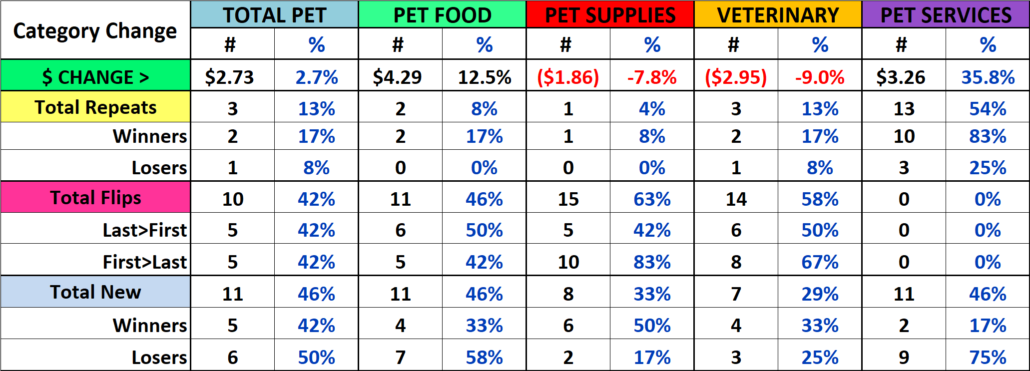
- Food & Services $ grew while Supplies & Veterinary $ fell. The resulting turmoil is most apparent in the $ changes.
- With 2 straight record increases, Services led the way in stability with repeats by 83% of 2021 winners.
- With big turnarounds in spending, Supplies (15), Veterinary (14) and Food (11) had the most flips. Veterinary & especially Supplies were mostly 1st to last while the Food flips were slightly positive. In a clear demonstration of widespread stability, Services had no flips.
- Both patterns were evident in Total Pet as 42% flipped but 1st to last & last to 1st were equal in number.
- There are a total of 24 winners and losers. Here’s the number different from 2021. Food: 22; Supplies: 23; Veterinary: 21; Services: 11; Total: 21. Any change in growth pattern causes more turmoil at the segment level.
Next, there were so many positive contributors that in each individual report we recognized 6 segments that didn’t win but still performed so well that they deserved Honorable Mention. I reviewed that list again and came up with segments that won Honorable Mention at least twice. Here are the 9 “SUPER Honorable Mentions” for 2022…
9 segments made the list, the same as 2021. Services had the biggest increase, +36%, but had only 1 segment on the list. 5 of their honorees either won in other segments or didn’t make the honor role. Food & Total Pet both had spending increases and tied for the lead with 6 segments on the “Super” list. All segments on this year’s list are generally “low profile” but contributed notably to the industry. We should give special kudos to Single Parents and those with an income of $40>49K. These 2 groups won Honorable Mention in 2 Industry segments and Total Pet.
Although the results were mixed, with numerous individual changes, here are some trends of note:
- Older Youth Movement – Boomers must inevitably fade. The Gen Xers are firmly at the top with spending skewing towards their older, wealthier members. Millennials are close behind and now Gen Z is “in the game”.
- The “Magic” number is 3+ – As spending has skewed younger the best performers in all but Services have 3 or more people. However, 2 person CUs still have the largest share of CU’s, 32.7% and 100+% performance in Total Pet and every segment. They’re not done yet.
- Improved spending balance – The performance gap between the best and worst narrowed in Total Pet and all segments. The disparity is now less than in 2019 for all but Supplies. However, we should note that Supplies narrowed the gap by 40% and their current disparity is only 0.7% more than 2019.
- Income is still the most important factor – The gap between best and worst narrowed in Total and all segments, but the disparity is still the biggest of any category. The best performer is always $150K+, while the worst is <$30K.
And Finally, What you have all been waiting for…
THE ULTIMATE 2022 PET SPENDING CUs – Side by Side
Color Highlighted cells are different from Total Pet; * = New in 2022
Methodology – The segments are chosen because they have the highest annual CU spending of any segment in the category. They may or may not have the most total dollars. That would depend upon the number of CUs in the group.
Final Comment – These “winners” further reinforce the key factors in increased pet spending:
Marriage– A commitment to another person demonstrates that you can make a commitment to your pet “children”.
CU Size – The “magic” number is 3+ for all but Services.
Homeownership/Area – Owning and controlling your own space has long been a key factor in Pet Parenting.
More space – Small suburbs near a big metro area offer the convenience of the city, plus room for more pets.
Income Matters Most – High Income, A High Paying Occupation, A College Degree, Everyone works with 2+ Earners. These are characteristics present in all of the Ultimate Pet Spending CUs.
Generation/Age – The highest income, 45>54 yr-old Gen Xers “rule”.
Region – Take your pick – Midwest or West, just not the Northeast or South.
I hope that this Visual Comparison helped you to get a “satellite view” of Pet Industry Spending in 2022. Please refer back to the individual segment reports to get more details.
There is one consistent winner in the Pet Industry…
…OUR PET CHILDREN




